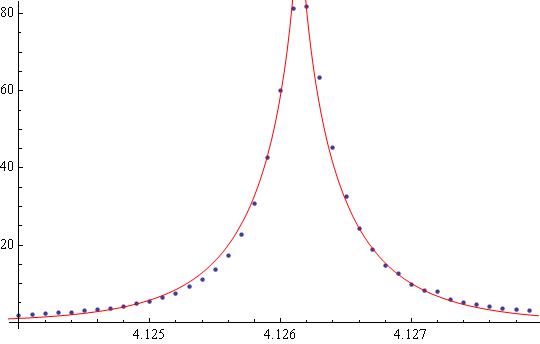Turns out I've got a bit of spare time, so here goes!
Following the information provided in the Wikipedia article on spectral lines, the model function you want for a Lorentzian is of the form:
$$
L=\frac{1}{1+x^{2}}
$$
where
$$
x=\frac{A-x}{B}
$$
with $A$ and $B$ as the position of the maximum, and twice the FWHM, respectively.
Now let's look at your model - notice the brackets around the parameter d - without it, the function is going to be $=1/0$ at the middle of the peak.
model = a/(((b - f)/c)^2 + d);
result = NonlinearModelFit[data,
model, {{a, 82.17435}, {b, 4.126155}, {c, 0.000283}, {d, 1.}}, f,
MaxIterations -> 500];
result["BestFitParameters"]
fitplot1 =
Show[ListPlot[data],
Plot[result[f], {f, 4.124, 4.133}, PlotRange -> Full]]
(* {a -> 86.104, b -> 4.12616, c -> 0.000276, d -> 1.05174} *)
And this result gives the following graph:

But what if I try it with different starting parameters?
model = a/(((b - f)/c)^2 + d);
result = NonlinearModelFit[data,
model, {{a, 82.}, {b, 4.126}, {c, 0.0002}, {d, 2.}}, f,
MaxIterations -> 500]
result["BestFitParameters"]
(* {a -> 123.998, b -> 4.12616, c -> 0.000230629, d -> 1.51461}*)
This still fits, but the parameters are all very different!
Heck, let's play around with the Method options of NonLinearModelFit.
I'll use Method->{NMinimize} here as per Methods for NonlinearModelFit, to perform a global optimization, with no initial guesses needed.
model = a/(((b - f)/c)^2 + d);
result = NonlinearModelFit[data,
model, {a, b, c, d}, f,
MaxIterations -> 500, Method -> {NMinimize}]
result["BestFitParameters"]
result["AdjustedRSquared"]
result["AIC"]
fitplot1 =
Show[ListPlot[data],
Plot[result[f], {f, 4.124, 4.133}, PlotRange -> Full]]
(* {a -> 6.14622, b -> 4.12616, c -> 0.00103591, d -> 0.0750752} *)
(* AdjustedRSquared = 0.997582 *)
(* AIC = 142.984 *)
Notice how the parameters are again different, but the result looks the same:

Now let's remove d from the equation and replace it with 1.
model = a/(((b - f)/c)^2 + 1.);
(* {a -> 81.8689, b -> 4.12616, c -> 0.000283838} *)
(* AdjustedRSquared = 0.997648 *)
(* AIC = 140.984 *)
Marginally better.
Also, let's put your data here rather than in a file.
data = {{4.124, 1.823}, {4.1241, 1.993}, {4.1242, 2.184}, {4.1243,
2.403}, {4.1244, 2.612}, {4.1245, 2.919}, {4.1246, 3.257}, {4.1247,
3.637}, {4.1248, 4.133}, {4.1249, 4.76}, {4.125, 5.506}, {4.1251,
6.339}, {4.1252, 7.448}, {4.1253, 9.307}, {4.1254,
10.956}, {4.1255, 13.628}, {4.1256, 17.32}, {4.1257,
22.68}, {4.1258, 30.794}, {4.1259, 42.704}, {4.126,
59.972}, {4.1261, 81.436}, {4.1262, 81.723}, {4.1263,
63.309}, {4.1264, 45.292}, {4.1265, 32.623}, {4.1266,
24.327}, {4.1267, 18.823}, {4.1268, 14.627}, {4.1269,
12.612}, {4.127, 9.732}, {4.1271, 8.272}, {4.1272, 7.902}, {4.1273,
6.021}, {4.1274, 5.232}, {4.1275, 4.523}, {4.1276,
4.023}, {4.1277, 3.602}, {4.1278, 3.212}, {4.1279, 3.025}}







f = b. My answer below is based on it being Lorentzian. $\endgroup$